What is happening in our yard….. Birds and Butterflies!
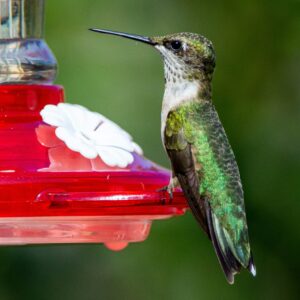
Most of us living in the lower 48 states are still in the midst of migration. Here in central Illinois, most of the birds who spend the spring and summer with us have left for their winter homes. One of the exceptions is the Ruby-throated Hummingbird. Although most hummingbirds are gone, we still have a few stragglers – some were our summer residents, and some are passing through. Cleon and I still have a female at our small feeder. She is by herself, and she has been guarding the feeder for over two weeks. We did have a few other hummingbirds from time to time – probably migrants – but she has fought them all off and we think they are gone. We suspect she will be gone this week. For all of us in Illinois, late September/early October is the general time to take the feeders down for the winter. However, if we want to extend a helping hand to late migrators, then we leave them up until November 15th. Always remember, hummingbirds migrate alone – and that includes juveniles. Late migrators are most often females and juveniles who were in a later nest. For more information for everyone in the lower 48 states as to when to take down your feeders – and when to put them up next spring – here is a link to an article I have on this website under Everything Bird!: Hummingbirds – Gardens and Feeders
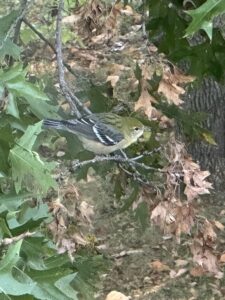
I was sitting at my desk on our second floor and working on the changes to this website that I talked about in the 10/1 blog. Just outside my windows is a very large and fully leafed-out pin oak tree. I saw a bird flitting a bit, in and around the leaves, and at first glance, I thought it was a female American Goldfinch. Those of you who watch the livestream from our bird feeders know we do have goldfinches, and the number increases in fall until we have more than a dozen through the winter months. But something about this quick ID based on a fleeting glimpse seemed just not right. So, I stopped what I was doing and started watching. I grabbed my cell phone, put the camera on its strongest zoom, and here are the photos I got.
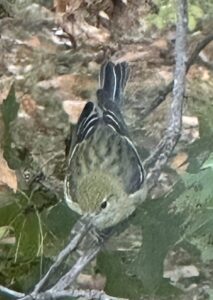
Not a female – or juvenile – American Goldfinch. This is a female Bay-breasted Warbler! And the first one we have seen in our yard. I did add it to our list of birds that I have included on this website – see the website menu. I added it to the ‘Occasional List’ as it is my guess, a few of these warblers are in our yard every spring and fall migration, but as they are small and higher up in the trees, they are easy to miss. And I would never have known she was there had I not caught the flutter in my peripheral vision. Also, notice the similarities to the female or juvenile goldfinch. The somewhat overall paler olive color. The white/pale markings on the folded wings. There are differences such as those dark stripes on the warbler’s back, but when a bird is flitting in, out, and around lots and lots of leaves, small features can be hard to see. It is perfect that my desk is upstairs and the pin oak is so close to my windows. As you can see by my photos, I got a straight-on view of her.
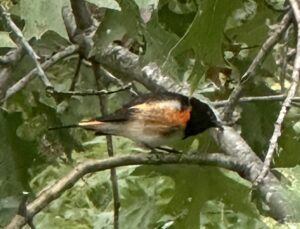
This morning, still sitting at my desk working, here was what was in just about the same place in that tree – a male American Redstart! And so easy to identify. The striking colors. The constant flitting. The constant opening and closing of his tail – flicking it. And of course, he does that to startle insects into moving and then, bam! Breakfast.
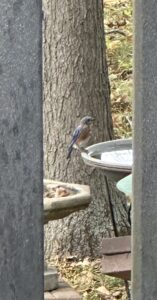
Cleon and I were sitting on the deck – which is why these photos were shot through the railing. We tried not to move, and I was so careful how I raised my cell phone. We did not want to scare these Eastern Bluebirds who were at the bird baths at the bird feeder area.
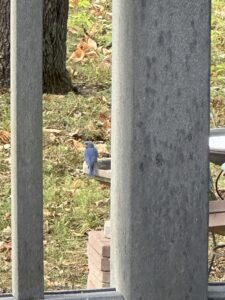
We do not often have bluebirds – although we did have a pair winter here in our yard last year. We did not see this pair in spring or summer, so they did not nest here, but we are guessing they nested somewhere in our neighborhood which is good bluebird habitat. Big trees and shrubs. Several unmown lots of tall grass and forbs.
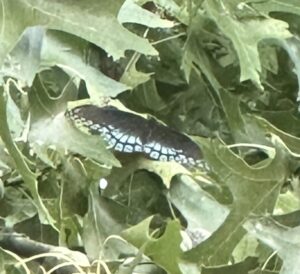
We have very few to no butterflies and moths here in spring and summer. I have a lot of flowers planted for them, but they are most often unused. We do get some butterflies and moths in late summer and fall. This year in September – and now October – we have had more of both than in all the 20 years we have lived here put together! It has been wonderful. Here is one (left photo) I saw in that magical pin oak tree so close to my window. It rested for almost 15 minutes, then moved on. I have never seen a butterfly rest that long in a tree so new behavior for me.
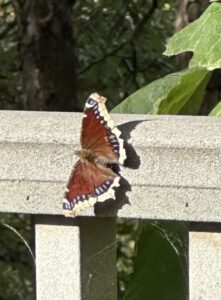
Another butterfly (photo on the right) was on the railing of our deck. Gorgeous! And one we have not seen in our yard before. Nothing like a glass of iced tea at the end of a warm afternoon, a comfortable chair outside, and a brand new butterfly to watch! Makes life worthwhile!

